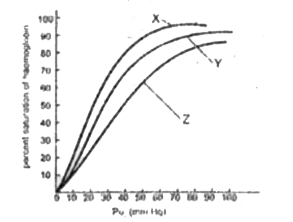The oxygen - haemoglobin dissociation curve will show a right shift in case of
high PCO2
high PO2
low PCO2
less H+ concentrations
The correct Answer is:A
Step-by-Step Solution:
1. Understand the Oxygen-Hemoglobin Dissociation Curve:
- The oxygen-hemoglobin dissociation curve illustrates the relationship between the partial pressure of oxygen (pO2) and the saturation of hemoglobin with oxygen. It typically has a sigmoid shape.
2. Identify Shifts in the Curve:
- A right shift in the curve indicates that hemoglobin has a decreased affinity for oxygen, meaning it releases oxygen more readily to the tissues.
- Conversely, a left shift indicates an increased affinity for oxygen.
3. Factors Causing Right Shift:
- The right shift can be caused by several physiological factors:
- Increased partial pressure of carbon dioxide (pCO2)
- Increased temperature
- Increased hydrogen ion concentration (lower pH)
- Increased levels of 2,3-DPG (2,3-diphosphoglycerate)
4. Analyze the Given Options:
- The options provided are:
- High partial pressure of carbon dioxide
- High partial pressure of oxygen
- Low partial pressure of carbon dioxide
- Less hydrogen concentration
- Among these, the option that corresponds to a right shift is high partial pressure of carbon dioxide.
5. Conclusion:
- Therefore, the oxygen-hemoglobin dissociation curve will show a right shift in the case of a high partial pressure of carbon dioxide.
- The oxygen-hemoglobin dissociation curve illustrates the relationship between the partial pressure of oxygen (pO2) and the saturation of hemoglobin with oxygen. It typically has a sigmoid shape.
- A right shift in the curve indicates that hemoglobin has a decreased affinity for oxygen, meaning it releases oxygen more readily to the tissues.
- Conversely, a left shift indicates an increased affinity for oxygen.
- The right shift can be caused by several physiological factors:
- Increased partial pressure of carbon dioxide (pCO2)
- Increased temperature
- Increased hydrogen ion concentration (lower pH)
- Increased levels of 2,3-DPG (2,3-diphosphoglycerate)
- The options provided are:
- High partial pressure of carbon dioxide
- High partial pressure of oxygen
- Low partial pressure of carbon dioxide
- Less hydrogen concentration
- Among these, the option that corresponds to a right shift is high partial pressure of carbon dioxide.
- Therefore, the oxygen-hemoglobin dissociation curve will show a right shift in the case of a high partial pressure of carbon dioxide.
Topper's Solved these Questions
- BOOK - NCERT FINGERTPS ENGLISHCHAPTER - BREATHING AND EXCHANGE OF GASESEXERCISE - Breathing And Exchange Of Gases140videos
BREATHING AND EXCHANGE OF GASES
- BOOK - NCERT FINGERTPS ENGLISHCHAPTER - BREATHING AND EXCHANGE OF GASESEXERCISE - Higher Order Thinking12videos
BREATHING AND EXCHANGE OF GASES
- BOOK - NCERT FINGERTPS ENGLISHCHAPTER - BODY FLUIDS AND CIRCULATIONEXERCISE - Body Fluids And Circulation151videos
BODY FLUIDS AND CIRCULATION
- BOOK - NCERT FINGERTPS ENGLISHCHAPTER - CELL - THE UNIT OF LIFEEXERCISE - Cell - The Unit Of Life159videos
CELL - THE UNIT OF LIFE
Similar Questions
Knowledge Check
- Question 1 - Select One
The oxygen dissociation curve will show a right shift in case of:
Ahigh PCO2Bhigh PO2Clow PCO2Dless H+ concentration - Question 2 - Select One
The oxygen dissociation curve is
AparabolaBslopeCsigmoidDstright line.
O2 dissociation curve is:
View SolutionDissociation curve shifts to the right when
View SolutionGo through the following statements
(i) the peripheral chemoreceptors for regulation of respiration are located in carotid veins and arch of aorta
(ii) the primary effect of pneumotaxic centre is to control the switch off point of inspiratory signal and thus limit inspiraton
(iii) the chemosensitve area for brain for respiratory control is highly sensitive to O2 concentration
(iv) In case of fetal haemoglobin the oxygen haemoglobin dissociation curve is shifted toward left
which of these are correct ?
(a) i, ii & iv
(b) ii and iv
(c) ii, iii & iv
(d) iii and ivView SolutionThe dissociation curve is associated with
View SolutionThe following oxygen-haemoglobin dissociation curves explain the effect of pH on oxygen-affinity of haemoglobin. Find out option that gives the correct descending order of pH for X, Y and Z.
 View Solution
View SolutionRight-shift of oxygen-haemoglobin dissociation curve can occur due to
View Solution

